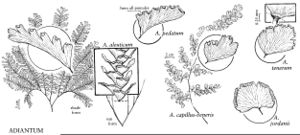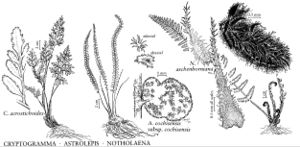Difference between revisions of "Pteridaceae"
FNA>Volume Importer |
imported>Volume Importer |
||
| (One intermediate revision by the same user not shown) | |||
| Line 164: | Line 164: | ||
|publication year= | |publication year= | ||
|special status= | |special status= | ||
| − | |source xml=https:// | + | |source xml=https://bitbucket.org/aafc-mbb/fna-data-curation/src/2e0870ddd59836b60bcf96646a41e87ea5a5943a/coarse_grained_fna_xml/V2/V2_509.xml |
}}<!-- | }}<!-- | ||
-->[[Category:Treatment]] | -->[[Category:Treatment]] | ||
Latest revision as of 20:23, 5 November 2020
Plants perennial [annual], on rock or terrestrial, of small (rarely large) stature. Stems compact to creeping, branched or unbranched, dictyostelic, bearing hairs and/or scales. Leaves monomorphic to dimorphic, circinate or noncircinate in bud. Petioles usually with persistent scales proximally, lacking spines; vascular bundles 1–several, roundish or crescent-shaped in cross section. Blades 1–6-pinnate, without laminar buds. Indument on petioles, rachises, costae, and blades, rarely absent or commonly of hairs, glands, and/or scales, occasionally of white or yellow farina. Veins pinnate or parallel in ultimate segments of blades, simple or forked, free or infrequently anastomosing in complex patterns. Sori borne abaxially on veins, often confluent with age and forming a continuous submarginal band, or sporangia densely covering abaxial surface (acrostichoid); receptacle not or only slightly elevated. Indusia (when present) formed by reflexed, recurved, or revolute leaf margin (false indusium). Sporangia stalk of 2–3 rows of cells; annulus vertical, interrupted by stalk; spores 64 or 32 (rarely 16) per sporangium. Spores all 1 kind, brown, black, or gray (rarely yellow), globose to globose-tetrahedral or trigonal, occasionally with prominent equatorial ridge, trilete, or trigonal, variously ornamented (usually cristate or rugose). Gametophytes green, aboveground, obcordate to reniform, sometimes asymmetric, usually glabrous (glandular-farinose in Notholaena); archegonia and antheridia borne on abaxial surface, antheridia 3-celled.
Distribution
Worldwide.
Discussion
Considerable disagreement exists concerning the circumscription and proper name of this family. The taxa comprising the Pteridaceae in this treatment were assigned to the Sinopteridaceae and Pteridaceae by D. B. Lellinger (1985) and were included in five families by R. E. G. Pichi-Sermolli (1977). The broad concept followed here is similar (except for the exclusion of Ceratopteris) to that espoused by R. M. Tryon and A. F. Tryon (1982), who applied the name Pteridaceae to the group. Until very recently, the newer name Adiantaceae was more commonly used.
As represented in North America, Pteridaceae comprise three major evolutionary lines (the adiantoids, the pteroids, and the cheilanthoids). Characteristics holding the family together include abaxial (usually submarginal) sori that lack indusia or are protected by a reflexed or revolute leaf margin, spores that are usually globose-tetrahedral and trilete, and chromosome base numbers of 30 or 29 (rarely 27). The xeric-adapted members of the family (particularly the cheilanthoids) have undergone extensive parallel and convergent evolution, and they have frustrated attempts to produce a natural generic classification based on macromorphologic characteristics alone. Although some workers have aggregated species into a few large genera (e.g., J. T. Mickel 1979b), most tend to recognize smaller segregate genera based on a combination of morphologic, chromosomal, and biochemical data. The latter approach seems to provide a more useful, evolutionarily informative classification and is the one adopted here. Aspidotis and Notholaena are maintained here as distinct from Cheilanthes, and three recently described genera (Argyrochosma, Astrolepis, and Pentagramma) have been incorporated into the treatment. The reasons for these changes in generic circumscription are discussed under the individual genera.
Genera ca. 40, species ca. 1000 (13 genera, 90 species in the flora).
Selected References
Lower Taxa
Illustrations
Key
| 1 | Sporangia borne directly on reflexed marginal lobes of ultimate segments, lobes separate and distinct; veins of ultimate blade segments prominent, dichotomously branched, essentially parallel distally. | Adiantum |
| 1 | Sporangia borne on abaxial leaf surface or, if seemingly attached to marginal lobes of ultimate segments, lobes confluent and poorly defined; veins of ultimate blade segments obscure or, if prominent, then pinnately branched and more divergent distally. | > 2 |
| 2 | Sporangia covering entire abaxial surface on fertile pinnae; veins strongly anastomosing throughout, forming several rows of areoles between costa and margin; mature leaves usually more than 1 m. | Acrostichum |
| 2 | Sporangia confined to marginal sori or scattered along veins but not covering entire abaxial surface of pinnae; veins free or rarely anastomosing, not forming several rows of areoles between costa and margin; mature leaves less than 1 m (occasionally longer in Pteris and Pityrogramma). | > 3 |
| 3 | Petioles longitudinally ridged and 2–3-grooved, containing 2 or more distinct vascular bundles (usually 1 in Pteris); spores with prominent equatorial ridge (lacking in Pityrogramma trifoliata); plants of disturbed or mesic habitats, mostly on southeastern coastal plain. | > 4 |
| 3 | Petioles rounded, flattened, or with single longitudinal groove adaxially, containing single vascular bundle (2 in Astrolepis, which has leaves covered with fringed or stellate scales); spores lacking prominent equatorial ridge; plants of rocky, mostly xeric habitats in continental interior, rarely found on southeastern coastal plain. | > 5 |
| 4 | Petioles green, straw-colored, or light brown distally; blades glabrous or sparsely pubescent, lacking white or yellow farina on abaxial surface; sporangia submarginal, often covered by reflexed leaf margin (false indusium). | Pteris |
| 4 | Petioles black or dark brown throughout; blades with white or yellow farina on abaxial surface (this sometimes lost in heat-treated specimens); sporangia following veins for most of length, not covered by reflexed leaf margin (false indusium). | Pityrogramma |
| 5 | Leaves strongly dimorphic, fertile leaves obviously longer than the sterile, with narrow, elongate, usually revolute ultimate segments; petioles green to straw-colored distally, essentially glabrous; mature spores usually yellow. | Cryptogramma |
| 5 | Leaves monomorphic to weakly dimorphic, either all alike and fertile or with a few sterile leaves poorly differentiated from the fertile; petioles brown to black and glabrous or pubescent, or if lighter, then sparsely to densely pubescent; mature spores brown to black, rarely yellowish. | > 6 |
| 6 | Blades 1-pinnate to pinnate-pinnatifid throughout, abaxial surface densely covered with fringed or stellate scales; petioles containing 2 vascular bundles. | Astrolepis |
| 6 | Blades 2–5-pinnate proximally or, if less divided, then abaxial surfaces glabrous or pubescent; petioles containing single vascular bundle. | > 7 |
| 7 | Blades with white or yellow farina on abaxial surface (concealed beneath fringed or stellate scales in Notholaena aschenborniana); stem scales either uniformly dark brown to black or bicolored with dark central stripe; ultimate segments sessile or subsessile, usually adnate to midrib. | > 8 |
| 7 | Blades without white or yellow farina on abaxial surface; stem scales yellow or brown to black; ultimate segments sessile or stalked or, if farinose (in Argyrochosma), then stem scales uniformly tan or brown and ultimate segments distinctly stalked. | > 9 |
| 8 | Sporangia confined to modified vein tips located near margin of ultimate segments; spores black to dark brown, appearing ± globose; gametophytes glandular-farinose. | Notholaena |
| 8 | Sporangia following veins for most of length, sometimes nearly covering abaxial surface of ultimate segments; spores tan to brown, distinctly trigonal; gametophytes lacking farina-producing glands. | Pentagramma |
| 9 | Blades conspicuously pubescent and/or scaly, hairs or scales often concealing abaxial surface, farina lacking. | > 10 |
| 9 | Blades glabrous or sparsely hirsute-pubescent or with whitish farina on abaxial surface, not conspicuously pubescent or scaly. | > 11 |
| 10 | Sporangia following veins for most of length; blades deeply pinnate-pinnatifid and pentagonal. | Bommeria |
| 10 | Sporangia submarginal; blades 2–4-pinnate or, if pinnate-pinnatifid, then linear to lanceolate. | Cheilanthes |
| 11 | Ultimate segments of blades linear to lanceolate; blades glabrous, lustrous on adaxial surface and often striate; false indusia broad, scarious, appearing inframarginal (obscurely so in A. californica), strongly differentiated from segment margin. | Aspidotis |
| 11 | Ultimate segments narrowly elliptic to round (occasionally linear); blades glabrous, farinose or sparsely pubescent, usually dull on adaxial surface, not striate; false indusia (when present) usually greenish or whitish, narrow, formed by revolute segment margin and poorly differentiated from it. | > 12 |
| 12 | Stem scales strongly bicolored, or if concolored, then largest ultimate segments more than 4 mm wide. | Pellaea |
| 12 | Stem scales concolored to weakly bicolored; ultimate segments usually less than 4 mm wide. | > 13 |
| 13 | Blades with whitish farina on abaxial surface or if glabrous, then ultimate segments somewhat cordate at base and attached to lustrous, dark-colored stalks. | Argyrochosma |
| 13 | Blades sparsely pubescent or glabrous, lacking whitish farina on abaxial surface; ultimate segments mostly rounded to truncate or cuneate at base, sessile or attached to dull greenish stalks. | Cheilanthes |


